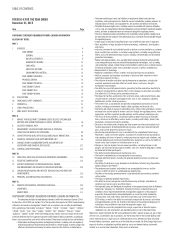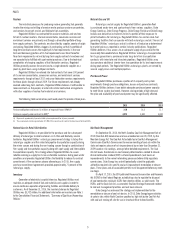Duke Energy 2015 Annual Report Download - page 29
Download and view the complete annual report
Please find page 29 of the 2015 Duke Energy annual report below. You can navigate through the pages in the report by either clicking on the pages listed below, or by using the keyword search tool below to find specific information within the annual report.
PART I
9
Nuclear
The industrial processes for producing nuclear generating fuel generally
involve the mining and milling of uranium ore to produce uranium concentrates,
and services to convert, enrich, and fabricate fuel assemblies.
Regulated Utilities has contracted for uranium materials and services
to fuel its nuclear reactors. Uranium concentrates, conversion services and
enrichment services are primarily met through a diversified portfolio of long-
term supply contracts. The contracts are diversified by supplier, country of origin
and pricing. Regulated Utilities staggers its contracting so that its portfolio of
long-term contracts covers the majority of its fuel requirements in the near
term and decreasing portions of its fuel requirements over time thereafter.
Near-term requirements not met by long-term supply contracts have been and
are expected to be fulfilled with spot market purchases. Due to the technical
complexities of changing suppliers of fuel fabrication services, Regulated
Utilities generally sources these services to a single domestic supplier on a
plant-by-plant basis using multiyear contracts.
Regulated Utilities has entered into fuel contracts that cover 100 percent
of its uranium concentrates, conversion services, and enrichment services
requirements through at least 2017 and cover fabrication services requirements
for these plants through at least 2019. For future requirements not already
covered under long-term contracts, Regulated Utilities believes it will be able to
renew contracts as they expire, or enter into similar contractual arrangements
with other suppliers of nuclear fuel materials and services.
Natural Gas and Oil
Natural gas and oil supply for Regulated Utilities’ generation fleet
is purchased under term and spot contracts from various suppliers. Duke
Energy Carolinas, Duke Energy Progress, Duke Energy Florida and Duke Energy
Indiana use derivative instruments to limit a portion of their exposure to
price fluctuations for natural gas. Regulated Utilities has certain dual-fuel
generating facilities that can operate with both natural gas and oil. The cost of
Regulated Utilities’ natural gas and oil is either at a fixed price or determined
by market prices as reported in certain industry publications. Regulated
Utilities believes it has access to an adequate supply of gas and oil for the
reasonably foreseeable future. Regulated Utilities’ natural gas transportation
for its gas generation is purchased under long-term firm transportation
contracts with interstate and intrastate pipelines. Regulated Utilities may
also purchase additional shorter-term transportation for its load requirements
during peak periods. The Regulated Utilities natural gas plants are served by
several supply zones and multiple pipelines.
Purchased Power
Regulated Utilities purchases a portion of its capacity and system
requirements through purchase obligations, leases and purchase contracts.
Regulated Utilities believes it can obtain adequate purchased power capacity
to meet future system load needs. However, during periods of high demand,
the price and availability of purchased power may be significantly affected.
The following table summarizes purchased power the previous three years:
2015 2014 2013
Purchase obligations and leases (in millions of megawatt-hours (MWh))(a) 14.9 14.3 11.7
Purchases capacity under contract (in MW)(b) 4,573 4,500 3,800
(a) Represents approximately 5 percent of total system requirements for all years presented.
(b) These agreements include approximately 421 MW of firm capacity under contract by Duke Energy Florida with QFs.
Natural Gas for Retail Distribution
Regulated Utilities is responsible for the purchase and the subsequent
delivery of natural gas to retail customers in its Ohio and Kentucky service
territories. Regulated Utilities’ natural gas procurement strategy is to buy firm
natural gas supplies and firm interstate pipeline transportation capacity during
the winter season and during the non-heating season through a combination of
firm supply and transportation capacity along with spot supply and interruptible
transportation capacity. This strategy allows Regulated Utilities to assure
reliable natural gas supply for its non-curtailable customers during peak winter
conditions and provides Regulated Utilities the flexibility to reduce its contract
commitments if firm customers choose alternate gas. In 2015, firm supply
purchase commitment agreements provided approximately 71 percent of the
natural gas supply.
Inventory
Generation of electricity is capital intensive. Regulated Utilities must
maintain an adequate stock of fuel and materials and supplies in order to
ensure continuous operation of generating facilities and reliable delivery to
customers. As of December 31, 2015, the inventory balance for Regulated
Utilities was $3,702 million. For additional information on inventory see Note 1
to the Consolidated Financial Statements, “Summary of Significant Accounting
Policies.”
Ash Basin Management
On September 20, 2014, the North Carolina Coal Ash Management Act of
2014 (Coal Ash Act) became law and was amended on June 24, 2015, by the
Mountain Energy Act. The Coal Ash Act established a Coal Ash Management
Commission (Coal Ash Commission) to oversee handling of coal ash within the
state and requires closure of ash impoundments by no later than December 31,
2029 based on risk rankings, amongst other detailed requirements. The Coal
Ash Act leaves the decision on cost recovery determinations related to closure
of coal combustion residual (CCR) surface impoundments (ash basins or
impoundments) to the normal ratemaking processes before utility regulatory
commissions. Duke Energy has and will periodically submit to applicable
authorities required site-specific coal ash impoundment remediation or closure
plans. These plans and all associated permits must be approved before any work
can begin.
On April 17, 2015, the EPA published Resource Conservation and Recovery
Act (RCRA) in the Federal Register, establishing rules to regulate the disposal
of coal combustion residuals (CCR) from electric utilities as solid waste. The
RCRA, and the Coal Ash Act, as amended, finalized the legal framework related
to coal ash management practices and ash basin closure.
Duke Energy has advanced the strategy and implementation for the
remediation or closure of coal ash basins. In 2015, Duke Energy began activities
at certain sites within North Carolina specified as high risk by the Coal Ash Act
with coal ash moving off-site for use in structural fill or to lined landfills.
























